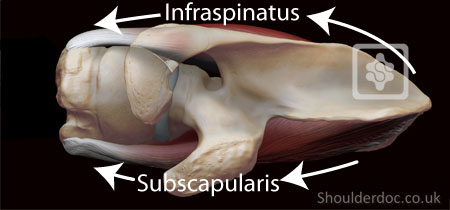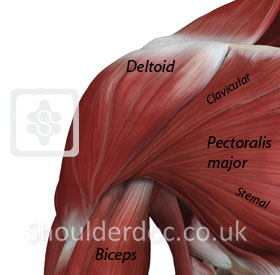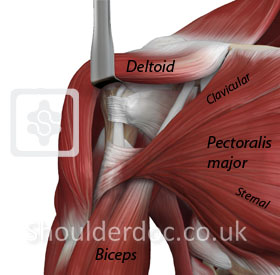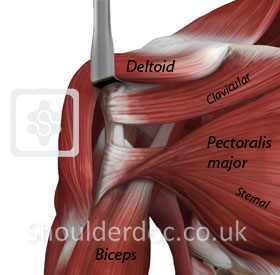Pectoralis Major Transfer
Failure of the subscapularis and anterior (in front) supraspinatus, leads to weakness and pain on activities that require pushing across the front of the body, such as lifting and gripping a heavy weight in front of you. It also leads to weakness in pulling objects across the front of your body. This is often disabling for heavy manual workers. These movements are known as 'internal rotation and forward flexion' and are controlled by the subscapularis and anterior supraspinatus tendons.
Fortunately, the pectoralis major muscle and tendon lie just below and in front of the subscapularis muscle, but too low to act as an internal rotator or flexor of the shoulder. The pec major also has a very broad tendon and therefore, part of it can be transferred without significantly affecting loss of strength.
ANATOMY PIC
As mentioned in tendon transfer principles, not everyone is suitable for a pec major transfer procedure and pre-operative planning is essential before proceeding. An MRI scan is most beneficial as it informs about the size of the tear, retraction of the tendons and the degenerative status of the attached muscles and quality of the shoulder joint. It also shows the quality and bulk of the pec major muscle to be transferred. It is essential that the posterior cuff (infraspinatus and teres minor) is intact and functioning to ensure balancing of the force couples. Without this the transferred muscle will have nothing to work against and fail to function.
Force couple between subscapularis at the front and infraspinatus at the back of the shoulder joint:

OPERATIVE TECHNIQUE:
The operation is performed under general anaesthesia with an interscalene block.
An incision is made at the front of the shoulder and the torn tendons are examined to assess for any chance of repair. Usually one half to two thirds of the pec major tendon is detached and mobilised. It is then moved as high up the humerus as possible to exert a downward and internal rotation force on the shoulder, compensating for the subscapularis and suprapinatus muscles.
It is essential for the surgeon to get the tension of the repair right. This depends on skill, training and experience. The transferred tendon is fixed to the bone with multiple strong suture-anchors.



COMPLICATIONS:
These are rare, but weakness of the biceps muscle is possible (approx. 5%). This is usually temporary and resolves after a few months. Other complications include infection, stiffness and failure of the transfer. The incidence of these is less than 1%.
POSTOPERATIVE MANAGEMENT:
The shoulder is immobilised in a sling for three weeks (stable fixation due modern suture anchors), and passive range of motion exercises for abduction, flexion, and internal rotation are begun on the first postoperative day. After four weeks, active range of motion exercises are begun in all planes including external rotation. After twelve weeks, full loading is permitted.
See Living with a Sling and Post-operative protocol
RESULTS:
These depend on numerous factors, and optimal recovery can take over one year to achieve. Approximately 70% improvement is expected in most people after one year.
References:
- Gavriilidis I, Kircher J, Magosch P, Lichtenberg S, Habermeyer P. Pectoralis major transfer for the treatment of irreparable anterosuperior rotator cuff
tears. Int Orthop. 2009 May 13. - Elhassan B, Ozbaydar M, Massimini D, Diller D, Higgins L, Warner JJ. Transfer of pectoralis major for the treatment of irreparable tears of subscapularis: does it work? J Bone Joint Surg Br. 2008 Aug;90(8):1059-65.
- Konrad GG, Sudkamp NP, Kreuz PC, Jolly JT, McMahon PJ, Debski RE. Pectoralismajor tendon transfers above or underneath the conjoint tendon in
subscapularis-deficient shoulders. An in vitro biomechanical analysis. J Bone Joint Surg Am. 2007 Nov;89(11):2477-84. - Jennings GJ, Keereweer S, Buijze GA, De Beer J, DuToit D. Transfer of segmentally split pectoralis major for the treatment of irreparable rupture of
the subscapularis tendon. J Shoulder Elbow Surg. 2007 Nov-Dec;16(6):837-42. Epub 2007 Nov 1. PubMed PMID: 17936023. - Guettler JH, Basamania CJ. Muscle transfers involving the shoulder. J SurgOrthop Adv. 2006 Spring;15(1):27-37. Review.
- Jost B, Puskas GJ, Lustenberger A, Gerber C. Outcome of pectoralis major transfer for the treatment of irreparable subscapularis tears. J Bone Joint Surg Am. 2003 Oct;85-A(10):1944-51.
- Wirth MA, Rockwood CA Jr. Operative treatment of irreparable rupture of the subscapularis. J Bone Joint Surg Am. 1997 May;79(5):722-31


